Space News and Discoveries
The past 3 years have been rich in discoveries of all kinds: scientific, medicinal, archeological, and others. Here are 25 most prominent explorations made by scientists and researchers worldwide in the past year.

A piece of meteorite believed to be four and a half billion years old found by a group of researchers in Australia. Although controversial when it comes to the age of the Earth, it is believed the earth is younger. The Australian planetary geologist Phil Bland and his colleagues believe the meteorite is even older tan the earth.
The fragment of the meteorite fell on November 27 (2015) in the great Australian desert (the remote and arid interior of Australia), and then recovered on 31 December of the same year. Though it is a priceless discovery, in appearance it is nothing special. Weighing 1.7 kilograms, the object is a chondrite, a stony meteorite composed primarily of rock, metal accounting for only less than 35% of its weight.
Based on the trajectory that the fireball was taking when it crossed the Earth’s atmosphere, the researchers were able to trace, locate and recover the meteorite on November 27, 2015.
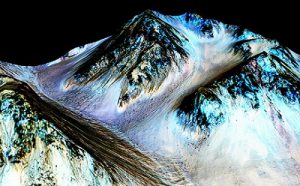
Water on Mars, regardless of the form (solid, liquid, gaseous, hydrated rock, etc.) has been always an interesting subject. Some scientists already believed it but there was not enough evidence until last year.
On September 28 (2015), NASA attested the presence of water on Mars. In addition, the US space agency said that the lines that cut the slopes of Mars could be streams of brine, a saturated liquid salt solution, which would confirm the potential existence of liquid water.
However, although this is essential to presence of life on this planet, brine is an extremely salty water which can destroy life instead protecting or saving it. Anyway, this is a great discovery.
It is important to know that the conditions on Mars are “very special”. This is a desert planet. It is a place where it is always extremely cold, extremely dry and where there is very little atmosphere. Especially because of temperatures often below those of the Earth, “we cannot have normal water, unsalted, on Mars except in solid form.
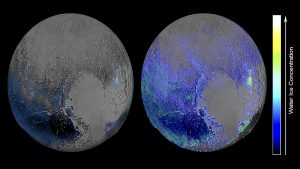
News pictures of Pluto from NASA reveal the complex surface of the planet. After nine years of waiting, almost 6.5 billion kilometers traveled with a record speed of 50,000 km / h (70 times faster than a passenger aircraft), New Horizons probe (from NASA) managed in July 14 (2015) to take some pictures of Pluto.
New Horizons is an interplanetary space probe that was launched as a part of NASA‘s New Frontiers program. The scientists waited for years for a moment like this to happen.
On Friday, Sept. 11, NASA released the new pictures of Pluto taken by the New Horizons probe. These pictures, some of which are very large detailed maps (up to 400 meters per pixel), unveil a series of puzzling non-flat surfaces on the planet as they are varied and complex.
The images show objects that look like dunes, water flows, and valleys that could have been dug by “materials” that have fallen on Pluto, according to NASA. “This is one of the youngest surfaces we’ve ever seen in the solar system,” said Jeff Moore of the New Horizons Geology, Geophysics and Imaging Team (GGI) at NASA’s Ames Research Center in Moffett Field, California.
“The surface of Pluto is as complex as that of Mars,” said Jeff More, researcher member of the mission.
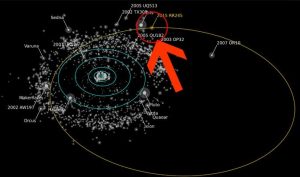
A group of astronomers discovered a new dwarf planet in the icy worlds of space located beyond Neptune, at about 17 billion kilometers from the sun.
An international team of astronomers announced the discovery of a new dwarf planet orbiting in the Kuiper Belt, icy bodies that orbit beyond Neptune. Located at 7.5 billion kilometers from our star, this new object, about 700 kilometers in diameter, takes about 700 years to orbit the sun.
Making use of the Canada–France–Hawaii Telescope, in Hawaii, as part of the Solar System Origins Survey (OSSOS), a team of researchers has pinpointed a new dwarf planet. Temporarily named RR245, the little body distinguished by its aphelion (the point on the path farthest from the Sun), which is estimated at 17 billion kilometers from the sun.
The small celestial body was first spotted in February 2016 by John J. Kavelaars of the National Research Council (NRC), as he peered images of September 2015 taken by the telescope Canada-France-Hawaii on Mauna Kea, a dormant volcano in Hawaii.
“There it was on the screen… this dot of light moving so slowly that it had to be at least twice as far as Neptune from the Sun,” said Michele Bannister, postdoctoral researcher at the University of Victoria, British, who participated in the study.

In May, NASA announced the discovery of the brightest galaxy in the universe. It is called WISE J224607.57-052635.0, WISE being the name of the space telescope used by NASA. It has a luminosity 350,000 billion times larger than the sun.
NASA scientists have announced the discovery of the most luminous galaxy known to date: its radiation is equivalent to 300.000 billion of that of the sun. The researchers believe this prodigious light was produced by a supermassive black hole (SMBH), more than 12 billion years ago.
Imagine the brightest thing you know, the Sun for example. Well in this case, the image must be multiplied by 300.000 billion to get an idea of what astronomers have discovered. It took five years to the Jet Propulsion Laboratory scientists to detect it among multiple data that WISE has collected.
And why this super-bright galaxy shines so much? The answer of the researchers may be surprising: they think the phenomenon is caused by a supermassive black hole.
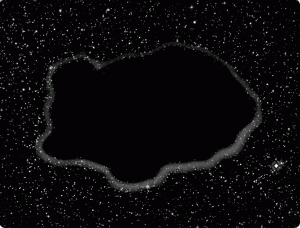
Astronomers have managed for the first time to capture some particles of the dark matter, this invisible substance that accounts for over 80% of the mass of the Universe when consider visible matter is account for only 20%.
Scientists shocked the world last February by announcing the finding of a mysterious signal, in the form of “Mysterious X-Rays”, from distant galaxy clusters.
After eliminating all possible explanations, one after the other to account for this observation, several groups of researchers come to the same conclusion: the signal can only be due to the presence of dark matter in these clusters.
They also believe it is a collision between four galaxies that allowed them to recognize that the clumps of dark matter that followed the “galaxies” had taken a distance, a delay of about 5000 light years.
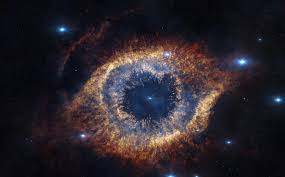 7. The Universe is dying slowly
7. The Universe is dying slowly
The results of an international study conducted over eight years using powerful telescopes show that the energy the universe produced has been reduced to half of what it used to be 2 billion years ago.
Universe is dying a slow death, says an international team of scientists who has measured the energy produced by 200,000 galaxies. They discovered it was two times less than that generated there about two billion years ago.
The researchers used seven of the most powerful telescopes in the world for eight years to observe galaxies in 21 different wavelengths, such as infrared and utraviolet, as part of the Gama (Galaxy and Mass Assembly) study. They have made the most accurate measurements of energy ever achieved in a fairly large portion of the space. The energy produced was halved and constantly decreasing, they discovered.
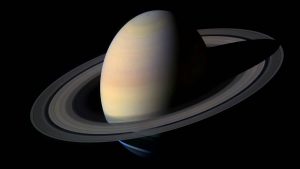
8. Planet with Rings 200 Bigger than Saturn
A group of U.S. and British astronomers has identified a system of giant rings around an extrasolar planet located hundreds of light years from Earth. Analysis of the giant planet reveals a ring system about 200 times larger than Saturn’s.
The discovery was possible through the use of data from SuperWASP project, which has enabled the collection of information on stargazing for 10 years. By observing one star, referenced in a previous eclipse, the researchers also discovered this set of rings.
Researchers at the Leiden Observatory (Leiden in Dutch) and National American University (Rochester, MN) have discovered about thirty giant rings around an exoplanet located 420-430 light years from Earth. These rings would be 200 times larger than those in the orbit of Saturn. The results of this study, published in The Astrophysical Journal, also showed that the diameter of the farthest ring of the planet was 120 million kilometers.
This is the first time that such a system is discovered outside the solar system. The scientists believe that “this planet is much larger than Jupiter or Saturn,” in addition to its vast rings.
Nicknamed “Super Saturn”
The planet, named J1407b and nicknamed “Super Saturn”, is invisible to the naked eye from Earth and is, according to researchers, particularly hot (between 1000 and 2000 degrees Celsius). Thus, astronomers now believe that these rings are made primarily of dust in contrast to those of Saturn, composed entirely of ice.
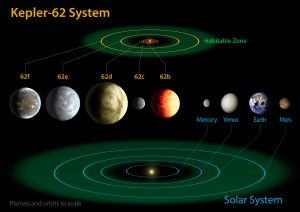
Another Earth has been discovered, says NASA. That was one of the most amazing space news of 2015. Having a diameter 60% larger than the Earth, the planet, Kepler-452b, is in a zone where liquid water could potentially be present. In other words, one could live there.
The US space agency (NASA) has filled the expectations of astronomy lovers by declaring that a new planet from near-Earth size was detected by satellite. The planet has been discovered in the habitable zone around a star of the same type as our Sun – but distant from 1400 light years.
With a diameter 60% larger than the Earth, Kepler-452b goes around its star in three hundred eighty-five days and is 5% more distant from it than we are from the sun. It is located in the habitable zone, one where liquid water, essential for life, would be likely to be present.
It is said that Kepler-452 (known as the 2MASS J19440088 + 4416392) is aged 6 billion years, 1.5 billion more than our planet, and also 20% brighter and 10% larger.



